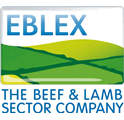16/01/08
Most English flocks should be able to make worthwhile economies
in their ewe feeding this winter to help offset escalating feed
prices.
 |
But, warns the English Beef and Lamb Executive (EBLEX), these
must be achieved through greater feeding precision rather than
across-the-board reductions in late pregnancy supplementation if
they are not to do more harm than good.
With ewe appetite declining by around 30% in the last six weeks
of pregnancy at just the time 70% of foetal growth is occurring,
it is all too easy to under-feed ewes unless sufficient levels
of relatively nutrient dense supplementary feeds are provided.
And under-feeding in the run-up to lambing is invariably damaging.
As well as low birthweight lambs and poor lamb vigour, it can easily
lead to low levels of colostrum production, poor colostrum quality,
reduced mothering ability and milk production problems in early
lactation.
Indeed, poor ewe nutrition is directly or indirectly responsible
for nearly 50% of the causes of lamb mortality. When the role of
concentrates as carriers for essential minerals and vitamins like
selenium, cobalt and Vitamin E as well vital supplementary sources
of energy and protein is taken into account, the importance of
adequate late pregnancy feeding cannot be under-estimated.
Be that as it may, there are a number of ways in which concentrates
can be used more effectively at this time. These primarily revolve
around accurate feed analysis, a good understanding of ewe requirements
and regular body condition scoring.
Accurate analysis of both the forage and concentrate feeds available
will avoid unnecessary as much as insufficient supplementation,
allowing savings to be made in many cases.
Equally, since many single-bearing ewes require little if any additional
concentrate feeding – in contrast to those bearing twins
or triplets – scanning and grouping ewes by litter size as
well as expected lambing date can yield further valuable concentrate
savings.
Body condition scoring throughout pregnancy – and in the
latter stages, in particular – is very valuable in both monitoring
and fine-tuning feeding. As a rule, ewes should lamb at BCS 3 and
feeding should be designed to ensure they lose no more than 0.5
units of body condition in the final six weeks.
Blood testing a sample of late pregnancy ewes can also be useful,
with beta-hydroxybutyrate levels providing a good indicator of
how much body fat ewes are mobilising and, therefore, the adequacy
of their diet.
Practical advice on ewe feeding is provided in the easy-to-read
Target Ewe Management for Better Returns manual and other Sheep
Better Returns Programme materials available free of charge to
English levy payers from EBLEX on 0870 2418829 or by e.mailing
info@eblex.org.uk. More detailed feeding information and guidance
can be obtained through the interactive Lamb Action for Profit
website resource at www.eblex.org.uk.
 Rare Breeds Watchlist Update 2008 Rare Breeds Watchlist Update 2008
 Further Clarification of New Rules on Sheep Double-Tagging Further Clarification of New Rules on Sheep Double-Tagging
 UK
Sheep Breeding Stock Exports Resume UK
Sheep Breeding Stock Exports Resume
|




